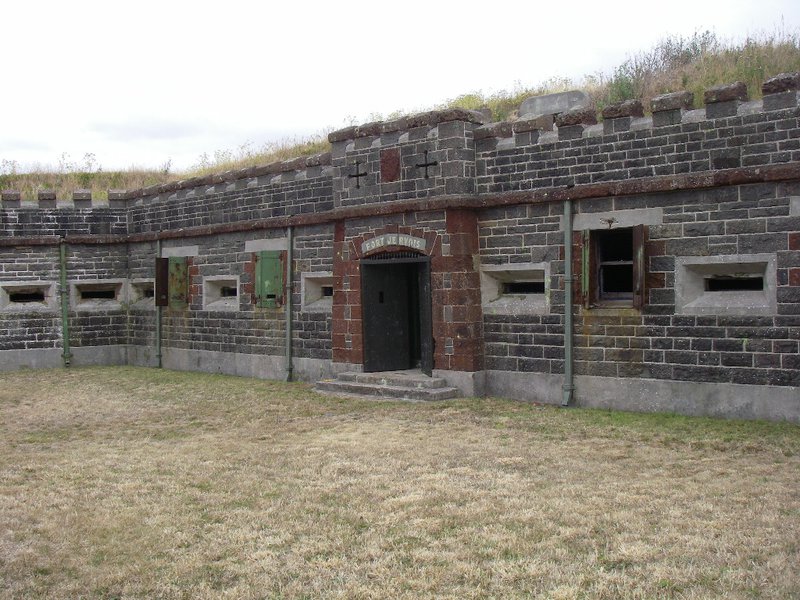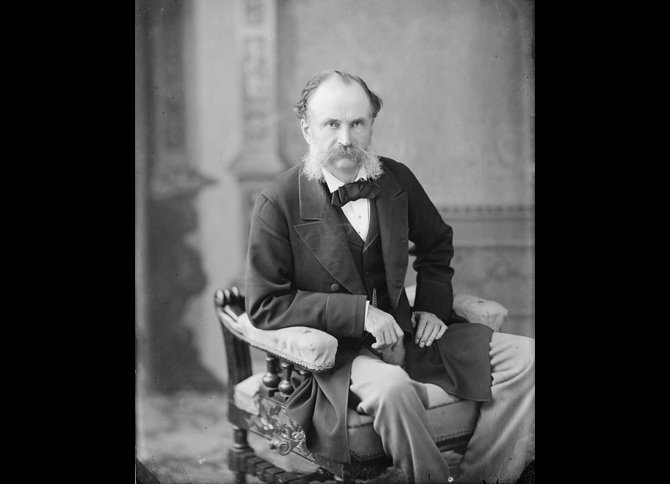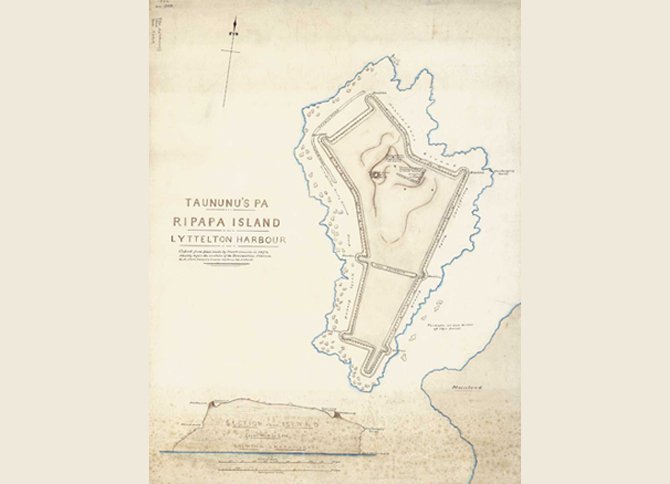Located on Ripapa Island in Lyttelton Harbour, Fort Jervois is considered one of the best examples of the Victorian-style fort in New Zealand today.

Fort Jervois (4th February 2009). Image Credit: Megan Hieatt (Wikimedia Commons).
Here Come the Russians
Fort Jervois was commissioned in response to the ‘Russian-scare’ that gripped New Zealand in the 1880s. When the Daily Southern Cross ran a fake story in 1873, detailing the threatening appearance of the “iron-clad man-of-war Kaskowiski” in Waitematā Harbour, the possibility of invasion prompted a call for urgent action to defend New Zealand’s vulnerable coastline. A network of coastal forts was established, known collectively as the ‘Russian-scare forts’.

Former Governor Lieutenant General Sir William Francis Drummond Jervois, ca.1886, for whom Fort Jervois is named. Image credit Herman John Schmidt. Ref: 1/1-001430-G. Alexander Turnbull Library, Wellington, New Zealand. /records/22748443
Fort Jervois is named for former-Governor Sir William Francis Drummond Jervois (1821-1897), a Lieutenant General and Governor of New Zealand from 1882 to 1889, who was instrumental in strengthening the naval defences of Britain’s Australasian colonies. The fort was designed by Lieutenant Colonel E.M. Tudor-Boddam and, later, Arthur Wilbraham Dillon Bell (1856-1943), both Engineers-of-Defence. Construction began in 1886.

Derelict guns at Fort Jervois (4th February 2009). Image Credit: Megan Hieatt (Wikimedia Commons).
'Disappearing' Guns
The fort’s famous Armstrong hydro-pneumatic ‘disappearing guns’, arranged in a quadrilateral pattern, were designed to use the energy generated from the gun’s recoil to return it to firing position. Fort Jervois hosted, at its zenith, two 8-inch, two 6-inch hydro-pneumatic guns, and two Nordenfeldt quick-fire guns. Only two of the hydro-pneumatic guns remain today, their potential as scrap metal not enough to justify their difficult removal. The guns, shipped from Britain, were installed by 1889, though the fort was not fully operational until 1895.
Even before its completion, criticism of the fort’s design emerged, arguing that the guns were positioned too close together and the island presented an easy target. It was suspected that the fort would collapse if all four of its guns fired simultaneously. This was never put to the test, however. The guns at Fort Jervois were never fired in anger.
Today, the fort is regarded as one of the best remaining examples of a ‘Russian scare’ fort in New Zealand. A castellated wall with loop-holed windows, a sea wall which encompasses the entire fort, and at one time a drawbridge are distinctive features of its design.

Taununu's pa, Ripapa Island, Lyttelton Harbour, ca.1872. Imge Credit: Copy of plan (ca.1910) made by Frederick Strouts (1834-1919) in 1872 [copy of ms map]. Ref: MapColl-834.44hkcmf/1872/Acc.5099. Alexander Turnbull Library, Wellington, New Zealand. /records/23027745
A Rich History
Ripapa Island, or ‘mooring rock’, also known as Ripa Island, was originally the site of a pā built by the warrior-chief Taununu of Kaikoura. In 1880, Ripapa was briefly used as a prison for over 150 Te Whiti followers, who were imprisoned without trial in the wake of the Parihaka Invasion, before Fort Jervois was built. The fort was occupied by the military during both World Wars.
During the First World War, the fort was the prison of the Ripapa Island Martyrs, a group of 97 military-service defaulters, for three months. Beer was sold illegally at the fort’s canteen for three-pence a glass in 1915. From January to May 1918, it was the prison of Count Felix von Luckner (1881-1966), the famous German prisoner-of-war, who had previously escaped from Motuihe Island in the Hauraki Gulf. The fort’s yard was made into a cage to prevent another of Luckner’s daring escapes.
Fort Jervois was abandoned in 1945 and management of Ripapa Island was taken over by the Lyttelton Harbour Board. Ripapa Island has been managed by the Department of Conservation since 1990.
More information
Heritage Recognition
Fort Jervois is recognised by Heritage New Zealand Pouhere Taonga as a Category 1 Historic Place (list no. 5306). See: www.heritage.org.nz/the-list/details/5306.
IPENZ “Engineering to 1990” project
Fort Jervois was recognised by Engineering New Zealand as part of the Engineering to 1990 project.
New Zealand Archaeological Association
The site is in the New Zealand Archaeological Association Site Record as site N36/119. See ARCHSITE
Further reading
Ansley, Bruce and Jane Ussher. Islands: A New Zealand Journey. New Zealand: Godwit, 2016.
Cooke, Peter. Defending New Zealand: Ramparts on the Sea, 1840-1950s. Wellington, New Zealand: Defence of New Zealand Study Group, 2000.
Glackin, Russell. In Defence of Our Land: A Tour of New Zealand’s Historic Harbour Forts. Auckland, New Zealand: Penguin, 2009.
Related Heritage Record entry
North Head Waitematā Harbour Coastal Defence
Access
Go to the Department of Conservation website for more information: www.doc.govt.nz/parks-and-recreation/places-to-go/canterbury/places/banks-peninsula-area/ripapa-island-historic-reserve/

